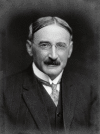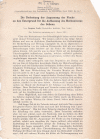Catalyzing Neurophysiology: Jacques Loeb, the Stazione Zoologica di Napoli, and a Growing Network of Brain Scientists, 1900s-1930s
- PMID: 30936823
- PMCID: PMC6432972
- DOI: 10.3389/fnana.2019.00032
Catalyzing Neurophysiology: Jacques Loeb, the Stazione Zoologica di Napoli, and a Growing Network of Brain Scientists, 1900s-1930s
Abstract
Even before the completion of his medical studies at the universities of Berlin, Munich, and Strasburg, as well as his M.D.-graduation - in 1884 - under Friedrich Goltz (1834-1902), experimental biologist Jacques Loeb (1859-1924) became interested in degenerative and regenerative problems of brain anatomy and general problems of neurophysiology. It can be supposed that he addressed these questions out of a growing dissatisfaction with leading perceptions about cerebral localization, as they had been advocated by the Berlin experimental neurophysiologists at the time. Instead, he followed Goltz and later Gustav Theodor Fechner (1801-1887) in elaborating a dynamic model of brain functioning vis-à-vis human perception and coordinated motion. To further pursue his scientific aims, Loeb moved to the Naples Zoological Station between 1889 and 1890, where he conducted a row of experimental series on regenerative phenomena in sea animals. He deeply admired the Italian marine research station for its overwhelming scientific liberalism along with the provision of considerable technical and intellectual support. In Naples, Loeb hoped to advance his research investigations on 'tropisms' further to develop a reliable basis not only regarding the behavior of lower animals, but also concerning perception and general neural capacities. He thought that he could demonstrate the existence of center interdependence in the cerebral cortex of higher animals and humans, and was convinced that regenerative phenomena existed as plastic mechanisms influencing animal as well as human behavioral qualities. This new perspective on the organization of brain functioning and Loeb's astonishing successes in experimental research with hydrozoa and echinoidea brought him in close contact with many biologists working on the nervous system during the early twentieth century. Yet, it is impossible to conceive of Loeb's ground-breaking experiments without also taking his contemporary scientific network of teachers, colleagues, and local research milieus into account. All of these exerted a strong influence on a growing network of physiology, anatomy, and neurology peers and research trainees, who went on to interact in early brain research centers in Central Europe and North America. This article explores some intellectual and organizational influences that developed out of Loeb's early experiences at the Naples Zoological Station in Italy. The main focus is laid here on questions of the structure and organization of scientific institutions, the development of research networks among biologists of the nervous system, as well as the emergence of an interdisciplinary research style during the early decades of the twentieth century. This innovative style of laboratory investigations later influenced the make-up of a number of research units, for example at the Kaiser Wilhelm Society in Germany and the Rockefeller Institute for Medical Research in the United States.
Keywords: 20th cent. history of medicine; Germany; Italy; Jacques Loeb; United States; brain research; history of neuroanatomy; regeneration.
Figures





References
-
- Archives Départementales de Strasbourg (1891). Doctorat et Habilitationen; Thèses et Diplômes de Doctorat (Médecine). Strasburg: Archives Départementales de Strasbourg; séries AL 103, no. 1296, 2.
-
- Barnardino G. (2000). The ‘Stazione Zoologica Anton Dohrn’ and the history of embryology. Int. J. Dev. Biol. 44 523–535. - PubMed
-
- Bartelemez G. W. (1973). Charles Judson Herrick. Biogr. Mem. Acad. Sci. 43 77–108. - PubMed
-
- Benton A. (2000). Exploring the History of Neuropsychology: Selected Papers. Oxford: Oxford University Press, 213–221.
Publication types
LinkOut - more resources
Full Text Sources

